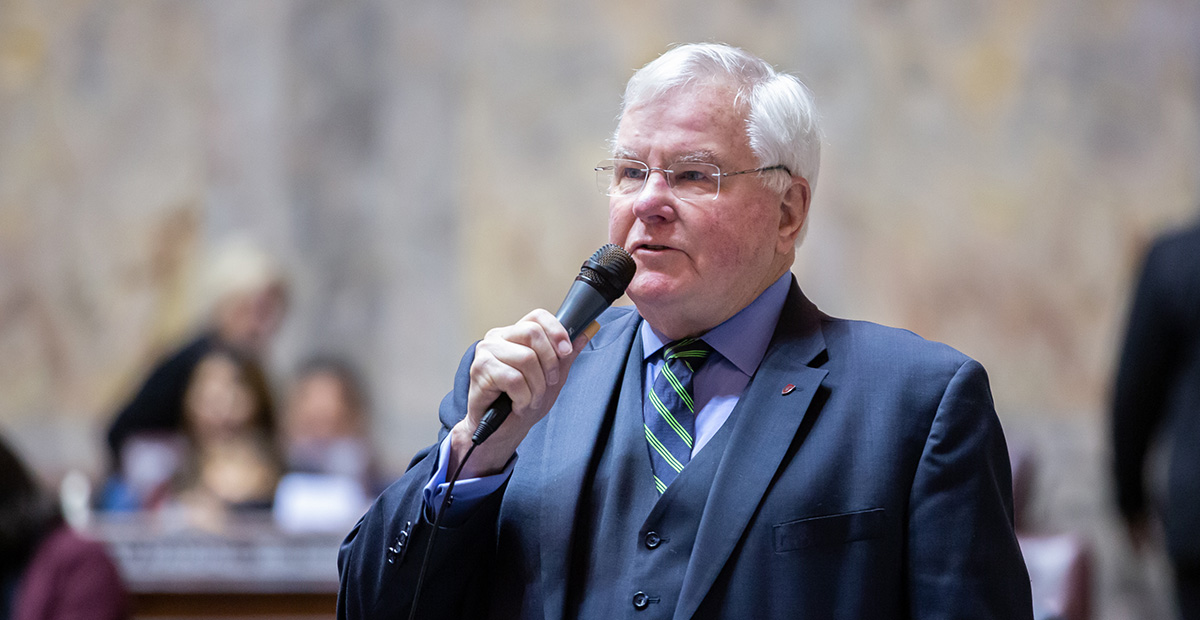President Joe Biden’s proposed budget for the 2023 fiscal year totals $5.8 trillion in spending.
Continue readingWomen’s History Month Profile: Jade Gingerich
By: Jade Gingerich, Elise Gurney, and Dalton Goble

Changing Maryland for the better, especially for people with disabilities, is an ongoing commitment for Jade Gingerich. Jade is the Director of Employment Policy at the Maryland Department of Disabilities. She is also a member of the Center for Advancing Policy on Employment for Youth (CAPE-Youth) National Working Group on Youth Transition, where she engages with other policymakers to discuss and share best practices around supporting youth and young adults with disabilities (Y&YADs) in their transitions to the workforce. In honor of Women’s History Month, Jade sat down for an interview with CAPE-Youth to discuss her leadership in the field of disability employment policy.
Tell us about your career journey and what led you to become the Director of Employment Policy at the Maryland Department of Disabilities.
I met someone who was an actor and ended up volunteering at the Model Secondary School for the Deaf, voicing their musicals, and coordinating a social club for young adults with disabilities. [At the same time I was] working and pursuing my master’s degree in Special Education with a specialization in Transition Services. I was working at the Clearinghouse on Postsecondary Education for Individuals with Disabilities when I saw an ad for Executive Director of the Maryland’s Governor’s Committee on Employment of People with Disabilities (GCEPD). GCEPD was part of the Governor’s Office for Individuals with Disabilities which was elevated and became the Maryland Department of Disabilities in 2004, and my position was transitioned into the Director of Employment Policy.
What is your favorite part about working in the disability employment policy field?
[My favorite parts] are the sheer variety of the work and being able to support emerging leaders, particularly minorities with disabilities. The barriers that exist are many: transportation, education, housing, healthcare, employer engagement and more. I love the opportunity to collaborate and work across partners for meaningful systems change for all individuals with disabilities. No two days are the same!
What are some of the biggest and most unique obstacles that women with disabilities face?
In addition to the inequalities they face as women in the workplace, women with disabilities have the added layer of misperceptions regarding the skills and abilities of people with disabilities. Moreover, expectations related to gender, such as those regarding childcare and occupational stereotypes, further impede access to education and careers, making women with disabilities more likely to be underemployed.
What has been your biggest career and/or personal achievement?
I am incredibly proud of the theatre company I created and ran for several years for individuals with and without disabilities, in particular the production of the musical “WORKING” by Studs Terkel. It really reflected my personal passion and professional values. In terms of my professional accomplishments, there are many, but of note are co-founding Maryland’s Youth Leadership Forum, co-chairing the workgroup to eliminate subminimum wage in Maryland, and serving as project director for Maryland’s Promoting the Readiness of Minors in Supplemental Security Income (PROMISE) grant, which was a large-scale research initiative to improve the education and employment outcomes of youth and their families that rely on Social Security Income (SSI).
What advice would you give young women about entering the workforce? What advice would you give to women who want to pursue your career?
The only failed job is one from which nothing has been learned. Get as much work experience as possible while in high school and college. Internships are great ways to build your network and your resume. Also understand the difference between being an external advocate who has the freedom to make statements and take any position you want, versus working for the government, where you need to figure out how to make the case and bring well-researched and well-thought-out solutions that satisfy multiple key stakeholders and their limitations, whether by federal law, funding, or other parameters. Don’t expect change to happen fast and be prepared to have to try multiple times, in different ways, before finding the right combination.
What inspires you?
I’m inspired by youth and their ability to embrace diversity of all kinds, particularly those self-advocates who are speaking up and out with pride, embracing and celebrating all facets of their being.
Jade’s push for progress demonstrates her commitment to honoring and embracing diversity, her collaborative leadership style, and her patience in pursuing complex and slow-moving systems change. Her approach serves as a model not just for women, but for all policymakers involved in disability policy. Much of Jade’s work concerns evidence-based practices to improve employment outcomes for people with disabilities across states. For example, Jade’s efforts to remove the various barriers to employment that people with disabilities face – including transportation, housing, and healthcare – align with the “Connecting Activities” component of CAPE-Youth’s evidence-based Guideposts for supporting Y&YADs in their transitions. In addition, her work to eliminate the subminimum wage in Maryland fits into a larger, nationwide movement to promote competitive integrated employment for people with disabilities.
Check here to learn more about the Maryland Department of Disabilities’ mission statement and various programs and services.
Next in Line: Kate Cruickshank’s Road to Leadership
By: Kate Cruickshank and Matthew George

Women’s History Month is a time to recognize women’s voices and highlight how their contributions changed communities and influenced their environments, culture and society. [i] Youth leadership has risen to the forefront as more women leaders enter the workforce. To honor Women’s History Month, the Center for Advancing Employment for Youth (CAPE-Youth) interviewed Kate Cruickshank, a third-year student at the University of Oklahoma majoring in Mathematics and Public Health and minoring in Medical Humanities. She also serves as a member of the Center for Advancing Policy on Employment for Youth (CAPE-Youth) working group, which was launched by the U.S. Department of Labor’s Office of Disability Employment Policy.
- Tell us about your education and career goals.
“I am a junior at the University of Oklahoma (OU), studying Mathematics and Public Health with a minor in Medical Humanities. My research has included projects looking at students’ perceptions of disabled students and accommodations at the undergraduate level and the experience of disability in undergraduate mathematics education. My career goals are broad, but I am firm in the direction of my profession: disability advocacy. I have long been a staunch proponent of accessibility, but it wasn’t until I myself became disabled that my drive for advocacy was solidified. I intend to enter a dual Juris Doctorate/Masters of Social Work degree program, with the hopes of developing a better understanding of how political and social systems affect individuals. Eventually, I would like to work in public policy, but believe it necessary to first work directly with communities and individuals. Wherever I end up, the ultimate goal for my career is advocacy.”
2. What advice do you have for young women with disabilities as they enter the workforce or postsecondary education?
“Getting acclimated to your university’s culture can feel disorienting for a time, and navigating these new spaces traditionally built for able bodies and minds may add a layer of complexity to your experience. My first and foremost suggestions for young disabled women entering postsecondary education is to get in touch with your disability services office. If you are unable to officially register for disability accommodations due to a lack of documentation, still reach out and ask how they can support you; being denied accommodations because you are unable to receive medical documentation can feel daunting and invalidating, but quite a few professors will be willing to work with you on a case-to-case basis.
Even with official accommodations, you may run into instructors who are disinclined or unaware of how to provide them for you. It is essential that you know what you are legally entitled to under the Americans with Disabilities Act (ADA), and the protocols that your school has in place for students who run into discrimination such as this. Requesting accommodations, especially with invisible disabilities, can feel like a double-edged sword because of the commonly held stereotypes about disabled students. If I don’t request accommodations in an attempt to avoid these stereotypes, I may have to work harder than my non-disabled counterpart to keep up. On the other hand, when I do ask for accommodations, I feel myself working extra hard to prove that I am not the stereotype—which none of us are, because there is no such thing as ‘normal.’ All and all, you belong, and you deserve to take up space—whatever that space may look like.”
3. What are some of the biggest and most unique obstacles that women with disabilities face?
“Disabled women experience double discrimination. Women’s medical concerns are oftentimes dismissed as existing ‘in their heads,’ effectively disqualifying their own experiences. This, for me, has complicated my feelings around disclosing my disability status; I want to advocate for myself and my needs, but I also don’t want others to perceive me through the lens of my disability. Speaking for myself as a woman in STEM (Science, Technology, Engineering and Math), I oftentimes feel as if I have to prove that I belong in these majority able bodied male spaces.
Sometimes though, no matter how much effort I put in, my sense of belonging remains the same. Since realizing this, I have stopped exerting my energy trying to fit into these spaces and have instead just begun to show up as myself—easier said than done, I know. Find places where you feel as if you and your knowledge are valued, and until you find those places, unapologetically take up space.”
4. Tell us about an accomplishment you are proud of.
“I recently completed my honors thesis examining the experience of disability in undergraduate mathematics classes with the intent of better understanding how these students understand their disability identities. My study was exploratory in nature, and after analyzing interviews with five disabled students I was able to identify a few factors within the mathematics learning environment that contribute to their disablement.
I was honored to present a poster of my work at the most recent Research in Undergraduate Mathematics Education (RUME) Conference this past February. There is little research in undergraduate mathematics education that prioritizes the disabled student’s experience, so I am proud that I was able to contribute to the mathematics education community in this way.”
5. What does leadership mean to you?
“A good leader is many things. They are accessible to the ideas and suggestions of others; they are willing to hand over responsibility to others, to delegate and place confidence in their team; they recognize the strengths and weaknesses of others while helping them to grow by supporting them in their endeavors; they allow for mistakes, which fosters a sense of safety and opens space for creative thinking. Above all, leadership demands empathy, honesty, commitment, dependability, and a strong ethical code in order to cultivate a community of care.”
[i] Congress, T. L. of, Administration, N. A. and R., Humanities, N. E. for the Art, N. G. of, Service, N. P., Institution, U. S. S., & Museum, U. S. H. M. (n.d.). Women’s History Month. Retrieved February 23, 2022, from https://womenshistorymonth.gov/about/
From the CSG Regional Offices: Don’t miss great upcoming programming and convenings
CSG EAST
61st Eastern Regional Conference
Aug. 14-17 | Manchester, New Hampshire
Each year, CSG East convenes state officials for a three-day conference, the largest gathering of state officials in the East. All of CSG East’s policy committees meet to discuss critical issues affecting the region in the areas of agriculture and rural affairs, Canada-U.S. relations, education and workforce development, energy and environment, fiscal affairs, military and veterans’ affairs, territorial relations, and transportation. CSG East’s Council on Communities of Color and Eastern Trade Council also meet at this conference. Learn more at csg-erc.org/annual-meetings
Eastern Leadership Academy (ELA)
Aug. 21-25 | Philadelphia
Application deadline: May 15
Thirty state and provincial officials from the 19 CSG Eastern Region member jurisdictions gather in Philadelphia each year for the Robert J. Thompson Eastern Leadership Academy. This select group of state officials from all three branches of government receives training to enhance their leadership and communication skills from a variety of experts in media, education and government. If you strive to be an effective leader, an informed decision-maker and an effective communicator, ELA is the program for you.
Held in partnership with the Fels Institute of Government, ELA is a unique opportunity to learn with the best and brightest from across the region. Learn more at csg-erc.org/leadership-training
EASTrain
The EASTrain service — customized legislative development training delivered to your state capital — is one of the major benefits of membership in CSG East. Comprehensive, customizable leadership training sessions are offered to member states by legislative leadership request and delivered in the state capitol at little or no cost to the state legislature. CSG East provides trainers who can work directly with legislative leaders and staff to develop programs tailored to their needs. CSG East seeks to include the following elements in its EASTrain programs:
- Training is always available on a bipartisan basis.
- Flexibility in selecting dates and times to encourage maximum attendance.
- Support in the promotion of the training program.
CSG MIDWEST
76th Midwestern Legislative Conference
July 10-13 | Wichita, Kansas
Each year, CSG Midwest convenes the largest gathering of Midwest state and provincial legislators. The event is designed by and for the region’s legislators and includes a mix of expert-and legislator-led policy sessions, insightful speakers and special events for attendees and their guests. Generations of legislators have taken part in the Midwestern Legislative Conference Annual Meeting where they are able to explore public policy and connect with fellow legislators in a nonpartisan, welcoming environment. Learn more at csgmidwest.org/annual-meetings
The Bowhay Institute for Legislative Leadership Development (BILLD)
Aug. 27-31 | Madison, Wisconsin
Application deadline: April 20
CSG Midwest BILLD is the only leadership training program designed exclusively for Midwestern legislators. BILLD helps newer legislators develop the skills necessary to become effective leaders, informed decision-makers and astute policy analysts. The Bowhay Institute is designed for Midwestern legislators in their first four years of legislative service. Learn more at
Under the Dome
With help and guidance from legislative leadership in individual states, CSG Midwest Under the Dome delivers customized training to lawmakers inside their state capitols or virtually, including briefings covering important policy areas and workshops focused on professional development and consensus building. Learn more at csgovts.info/underthedome
CSG SOUTH
76th Southern Legislative Conference
July 9-13 | Oklahoma City
Each year, CSG South convenes the largest gathering of Southern state and provincial legislators at the Southern Legislative Conference Annual Meeting. The event is designed by and for the region’s legislators and includes a mix of expert-and legislator-led policy sessions, insightful speakers and special events for attendees and their guests. Generations of legislators have taken part in this annual meeting where they are able to explore public policy and connect with fellow legislators in a nonpartisan, welcoming environment. Learn more at csgsouth.org/southern-legislative-conference/
Center for the Advancement of Leadership Skills (CALS)
Oct. 15-19 | Little Rock, Arkansas
Application deadline: July 30
CALS embodies the CSG South mission of championing excellence in state government and providing nonpartisan forums for state officials who might rarely cross paths to share ideas. The program brings together Southern state officials from three branches of government in a strictly nonpartisan environment. The class size is capped at 25 maximum state officials — representing all three branches of government — to foster connections among classmates. Learn more at csgsouth.org/CALS
The Staff Academy for Governmental Excellence (SAGE)
Nov. 13-16 | Atlanta
Application opens: April 18
CSG South SAGE is a professional leadership development program for Southern state legislative, judicial, executive and agency staff. In addition to developing their personal and professional leadership skills, participants have the opportunity to build a network of their peers from across the Southern region. Learn more at csgsouth.org/SAGE
CSG WEST
75th CSG West Annual Meeting
July 19-22 | Boise, Idaho
The annual meeting of CSG West is the largest gathering of Western legislators, convening over 500 participants each year. The size and scope of this event creates an intimate and unique environment for attendees to:
- Engage and exchange ideas through policy committee discussions on issues such as workforce development, fiscal affairs and social justice.
- Learn from topic experts by participating in educational forums and leadership skills training opportunities.
- Connect and build lasting relationships with regional, national and international colleagues.
Western Legislative Academy (WLA)
Dec. 13-16 | Colorado Springs, Colorado
Application deadline: April 28
CSG West provides premier capacity building opportunities for Western legislators within their first four years of cumulative service through the Western Legislative Academy. The WLA is an intensive three-and-a-half-day professional development program designed to assist legislators in becoming more effective leaders and to strengthen legislative institutions. The WLA focuses on communications, time management, governing, ethics and consensus building. A highlight of the program is a half day spent at the U.S. Air Force Academy working on personnel assessments and team building. Learn more at csgovts.info/wla
WESTrain
The CSG West WESTrain program provides in-state training for state legislators and staff on a variety of professional development topics. Trainers are leaders in their respective areas of expertise offering non-partisan perspectives and hands-on instruction on a range of relevant topics including communication, time management, stress management, as well as negotiation, consensus-building and conflict resolution. Learn more at csgovts.info/westrain
What’s in the Consolidated Appropriations Act?
The omnibus spending bill funds the government through September 2022.
Continue readingEyes in the Sky
Drones help states maintain infrastructure.
Continue readingAnnouncing the New CSG Leadership Team
National officers reinforces our mission of serving the states as a member-led organization
Continue readingThe Ambassador for Civics and Civility
Serving as 2022 CSG national chair, Washington state Sen. Sam Hunt champions democracy.
Continue readingPublic Works
Sponsored by The Council of State Governments and The Urban Institute, the Public Sector Apprenticeship Consortium explored workforce solutions.
Continue reading2022 Policy Preview: Resources for Your Year in State Government
These are the top issues we expect to be prominent in state leaders’ decision-making in 2022, along with insights from the CSG public policy research team.
Continue reading






